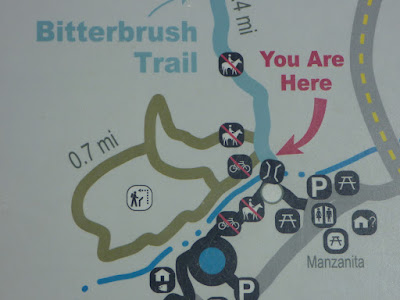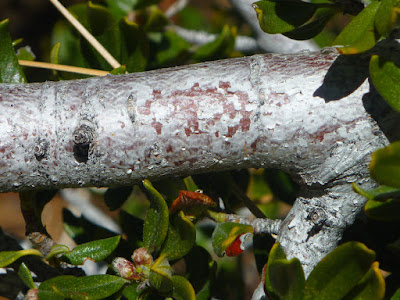 |
| Large granodiorite boulder fractured by frost wedging |
My favorite season to walk the
Galena Creek Nature Trail (
GCNT)—southwest of
Reno, Nevada—is spring, when the snow cover is receding and white water is rushing down
Galena Creek. Consider the nature loop for a warm-up hike to get ready for the
Jones White Loop Trail or an out-and-back trip to
Church's Pond—or grab a
Trail Guide brochure at the Galena Creek Visitor Center and simply explore the evergreens and trailside attractions along the nature path. Discover split rocks and trees with forked trunks and entertain in speculations on how bifurcation happens in nature.
The trail loops off and back to
Bitterbrush Trail through forest of Jeffrey pines and various brushes. Along the trail you will find 18 sites with a marker referencing the interpretation section in the brochure. Let's have a look at some of the sites.
At the
nature trail/Bitterbrush Trail junction next to the Galena Creek bridge you will see
tobacco brush. This evergreen is common on open-forest slopes of the Carson Range; found, for example, alongside
Kings Canyon Upper Waterfall Loop.
Snowbrush, its other name, highlights its inflorescences of long clusters with white flowers during bloom.
Ascending the nature trail alongside Galena Creek, which cascades downhill through the Mt. Rose wilderness from
Tamarack Peak, you will soon get to the sites comparing
Jeffrey pine and
white fir. The brochure explains that Jeffrey pines are the dominant pine tree species in the park, distinguished by 8 to 10 inch long needles in bundles of three and 5 to 10 inch cones with
in-turned prickles. Notice all the pine cones laying on the forest floor.
 |
| Fallen-off cone of Jeffrey pine with in-turned prickles |
The fir cones remain on the tree for a much longer time: after maturing, their scales are shed, leaving a central axis. Many seeds never germinate, but end up in the stomach of a squirrel.
 |
| Forked trunk of white fir |
The right-side photo depicts
trunk forking observed with several Galena Creek firs. According to the brochure “this is a rather odd coincidence. They usually grow tall and straight. Several other trees near the creek also have forked trunks. One possible explanation is that debris from past floods took the tops off these trees. When the top of a tree is cut off, growth occurs from remaining branches which fork into two or more trunks.”
From trees to brushes: continuing your round walk along the upper section of the nature trail, you will learn about
sagebrush,
Sierra willows,
curl-leaf mountain mahagony,
greenleaf manzanita and
bitterbrush.
 |
| Cinnamon-red bark of greenleaf manzanita branches |
Descending back toward Bitterbrush Trail, you will pass the
frost-wedged boulder shown in the top picture. This boulder is described in the brochure as a large
granodiorite rock that “is fractured in several straight planes. If you squeezed the pieces together, they would fit very closely. This was probably caused by minute quantities of moisture getting into cracks in the rock and freezing. As the water turned to ice it expanded and exerted pressure on the inside of the rock great neough to cause it to split. This process is known as frost wedging. If you wonder where the trail went, just continue walking through the rock.”
Walk through, don't get stuck and have fun with split-boulder squeezing!
 |
| Map with 0.7-mile-long Galena Creek Nature Trail (GCNT) |
Getting to Bitterbrush Trail and the adjoining Nature Loop
Get to the
South Entrance of the
Galena Creek Recreation Area. Find the entrance about three quarters of a mile south (uphill on NV-431) from the
North Entrance. The South Entrance is near the junction of
Douglas Fir Drive with
Mt. Rose Highway (
NV-431). For details and facilities, consult the zoomed-in map above or the
Galena Creek Recreation Area map. To pick up a
Galena Creek Nature Trail brochure, you want to first stop at the
Galena Creek Visitor Center near the North Entrance. Galena Creek Park phone number provided on brochure:
(775) 849-2511.























